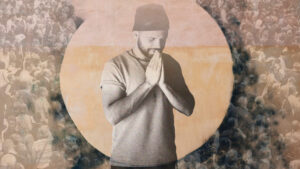I was standing in front of the mirror, examining a new bathing suit I’d purchased online when tiny feet pattered into the bathroom. Instinctively, I grabbed my towel to cover my body. I wish I could say it was out of modesty, but truth be told, my urge to cover up was birthed from shame. My body, the one that has taken me on so many adventures, still brings me deep shame.
Ever since my twin girls were little, I was determined that they’d never hear me complain about my body. While I spent nights rocking my babies, whispering promises about creating a safe space for them to honor the bodies God gave them, I never knew how many times I, their own mother, would break that promise.
And yet, as I’ve studied a theology of embodiment, I’ve come to realize that our bodies are gifts. As Gregg Allison writes, “Being made in the image of God entails the embodiment of the image bearers. Human embodiment, then, is according to divine design.” In other words, being an image bearer requires having a body.
This means that some of the very things I hate are a part of God’s good design.
Bodies are created by a good God for his good purposes. And although they, like the rest of the world, are affected by the fall, God uses them for his glory and our good. While we await Christ’s return, here are three ways to affirm God’s good design for our bodies and pass on a healthy body image to our children.
1. Use Scripture as the Foundation
It’s tempting to measure our bodies against the images our culture places before us, but the grand narrative of Scripture tells us a true and better story. Here are some truths that should reshape our thoughts:
- God created men and women in his own image, and he called us very good (Gen. 1:26–27, 31).
- We are called to present our bodies are living sacrifices, holy and acceptable to God. This is a form of worship (Rom. 12:1–2).
- We measure beauty not by earthly physical standards, but by inward character (1 Pet. 3:3–4).
- Christ will make things new—including our bodies. Although our current bodies are affected by the fall, God himself will give us eternal bodies one day (2 Cor. 5:1–5).
2. Redefine What Beauty Is—and Is Not
In light of the passages above, we should actively teach our children about our bodies and beauty.
For example, when defining beauty for our children, we begin with the “inner self” (1 Pet. 3:3–4). When our kids are kind, generous, gracious, or forgiving, we communicate how beautiful they are. When our children are having fun, we point out how brightly their joy shines. When we see our friends bringing glory to God through generosity, forgiveness, and faithfulness, we proclaim that they’re bringing beauty to a broken world.
At the same time, we don’t run away from aesthetics. When a friend shows up to our house and looks nice, we compliment them. When our family or friends are laughing, we comment on how beautiful their smiles are. When our kids are playing soccer, we tell them God made their legs strong, beautiful, and fast. When they get ready for a special event, we point out how gorgeous they look. In ordinary moments when we are struck by how beautiful God made them, we tell them with the hopes that our words will ring true when the world tells a different story. (This is especially important for fathers to model.)
While the world around us is staking claims on beauty, the Christian family has the opportunity to redeem it. We can gift our children with eyes to see beauty in others by recognizing the ways other people reflect God’s goodness.
3. Demonstrate Respect and Care for Our Bodies
We recognize that our bodies are temples of the Holy Spirit (1 Cor. 6:19), and so we care for them as gifts from our Creator. We don’t bemoan our hair, eyes, or size. Rather, we speak words of gratitude to our Creator God for the ways he’s uniquely made each of us. And when our bodies fail us, we anticipate our resurrected bodies to come (1 Cor. 15).
We model this for our children by taking care of our bodies. This means we fight against becoming obsessed with food or exercise; rather, we tend to our bodies in ways our unique body needs. It means we choose rest over hyper-productivity. We choose balance over obsession. We choose self-discipline and sanctification instead of lust, gluttony, and laziness. And we depend on God’s help for all of these things, acknowledging that we’re finite creatures.
We measure our bodies’ worth not by their capacity or function. Instead, we see our bodies and other bodies as beautiful, because we were made in the image of God, and they were designed for our good and his glory.
My body brought children into this world. It survived trauma. It sat next to friends so they wouldn’t be alone. It wrote countless words on pages and even ran marathons. And, although my body carries visible signs of the fall and is daily fading, it’s still beautiful because it reflects the goodness of God in this world.
So instead of covering in shame when my children glance curiously at what the world would call “problem areas,” it’s my hope to point them to an amazing Creator God who will make all things new, including my body.
“The Most Practical and Engaging Book on Christian Living Apart from the Bible”
 “If you’re going to read just one book on Christian living and how the gospel can be applied in your life, let this be your book.”—Elisa dos Santos, Amazon reviewer.
“If you’re going to read just one book on Christian living and how the gospel can be applied in your life, let this be your book.”—Elisa dos Santos, Amazon reviewer.
In this book, seasoned church planter Jeff Vanderstelt argues that you need to become “gospel fluent”—to think about your life through the truth of the gospel and rehearse it to yourself and others.
We’re delighted to offer the Gospel Fluency: Speaking the Truths of Jesus into the Everyday Stuff of Life ebook (Crossway) to you for FREE today. Click this link to get instant access to a resource that will help you apply the gospel more confidently to every area of your life.































